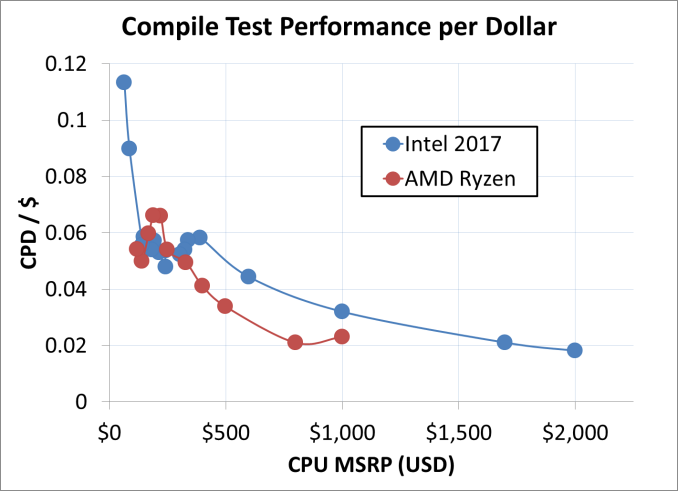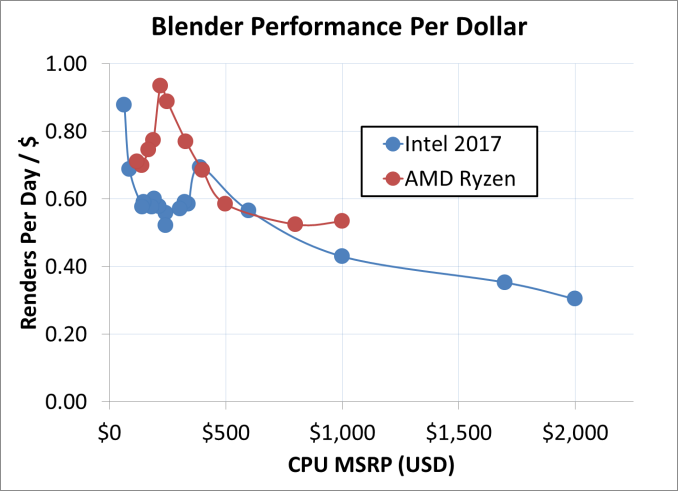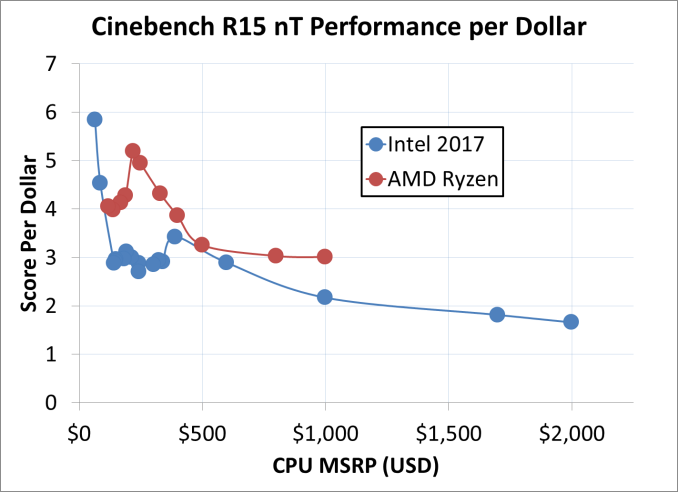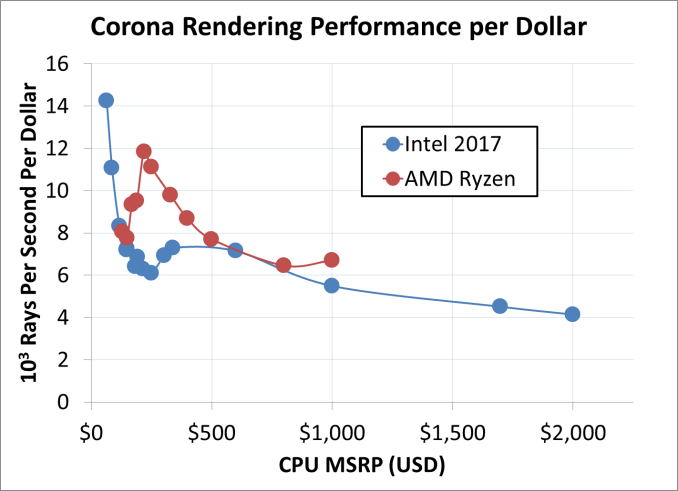The Intel Core i9-7980XE and Core i9-7960X CPU Review Part 1: Workstation
by Ian Cutress on September 25, 2017 3:01 AM ESTAnalyzing Performance Per Dollar
While measuring the performance per watt is an interesting metric, workstation processors are at the top of the stack when it comes to power consumption: the point of these processors (typically) is getting work done fast, and their users don't mind using a bit more power to get there. When it comes to designing a workstation level system for an office, the person who signs off on the project is not going to look at the performance per watt - they are going to look at the performance per dollar. Does this purchase represent the best value for the environment, and is the purchase likely to give us the best return? The following graphs attempt to answer that information, and we've chosen a varied selection including variable threaded loads.
For this analysis, we've taken all of the processors we have tested from what Intel has launched in 2017. This covers all of the consumer level Kaby Lake-S i7 and i5 parts (except T), the high-end desktop Kaby Lake-X processors, and all the high-end Skylake-X desktop parts. This is represented in the graphs in blue under the 'Intel 2017' title. From AMD, we have all eleven AMD Ryzen processors tested, under the red line.
Compile Performance Per Dollar
One of our popular benchmarks is our compile test. This takes a fixed version of Chromium v56, and runs it through the MSVC compiler with linking as per the directions given on by the Chromium developers. A typical test can run from 40 minutes to 3 hours depending on the processor, and taxes the single thread, the multi-thread and the memory performance of the system. We've seen that it does not particularly take kindly to processors with victim caches, such as Skylake-X or AMD Ryzen, with limited scaling on the code workflow. Despite the per-core performance dip from Skylake-S to Skylake-X, the top processor still has the best absolute performance. Converting our data to the number of compiles per day per dollar gives the following graph:
The cheaper end of the graph is surprisingly high, dominated by Intel's dual-core Pentium (with hyperthreading) being offered for super low prices. In the standard 'consumer' price range below $300, the mid-range Ryzen processors have a slight advantage, but, beyond the Ryzen 7 1700, Intel has the performance per dollar advantage all the way out to $2000.
Agisoft Performance Per Dollar
The Agisoft Photoscan software has been a key part of our performance testing for several years, demonstrating a true office workflow: archival purposes of taking 2D photos and converting them into 3D models. This is a computationally interesting algorithm, involving multiple single-threaded and multi-threaded stages.
Due to the single threaded elements of the algorithm, linear scaling is not observed as we ramp up through the core counts. At the mid-range consumer processor pricing, the twelve-thread Ryzen 5 processors sit above the quad-thread Core i5 parts, but beyond $330 or so, as we move into Intel's quad-core offerings and above, the performance per dollar is solely on Intel's side.
Blender Performance Per Dollar
The Blender benchmark has been an interesting debate in the last few months, with the new architectures from Intel and AMD pushing updates into the code for faster rendering. Our test takes a well used Blender release and one of the standard benchmarks (rather than anything vendor specified). Results are given in renders of this benchmark per day per dollar.
Interestingly AMD takes the peak PPD across the full range. At $999, where the competition is expected to be highest, AMD has over a 10% advantage. In the four digit range, even though the PPD of Intel's processors is lower, the absolute performance is still better. For our Blender test, this translates so a few seconds over a 2-3 minute test.
Cinebench R15 nT Performance Per Dollar
Next we move into the pure multithreaded benchmarks, which can be a significant number of workstation workloads. Here Intel might be at a disadvantage, with AMD offering more cores and more threads at each price point - Intel's IPC advantage will have to offset this in order to move ahead.
To lay some background here: AMD has been plugging Cinebench R15 nT benchmark numbers since the launch of Zen, citing better PPD. Intel's rebuttal is that in absolute performance, when you need the absolute best results, their hardware still wins.
Corona Rendering Performance Per Dollar
Ray tracing is another example of light threads taking advantage of more cores, more frequency, higher IPC and accelerated intructions with fast FP throughput. Citing back to Johan's EPYC review again, which showed AMD's good base FP performance, it will be an interesting comparison.
Similar to some of the previous graphs, the best PPD is held at Intel's low end Pentium processors - however these do not give the best overall throughput. In the mainstream price range, the Ryzen 5 1600 and 1600X are suprising peak results. In the $500-$800 range, Intel and AMD are about equal, however at $999 the Threadripper is ahead of the Core i9. Again, at the $1500+ range, Intel offers the better overall throughput, despite the lower PPD.















152 Comments
View All Comments
mapesdhs - Monday, September 25, 2017 - link
Just curious mmrezaie, why do you say "unofficially"? ECC support is included on specs pages for X399 boards.frowertr - Tuesday, September 26, 2017 - link
Run Unbound on a Pi or other Linux VM and block all thise adverts at the DNS level for all the devices on your LAN. I havent seen a site add anywhere in years from my home.Notmyusualid - Thursday, September 28, 2017 - link
@frowertrInteresting - But that won't work for me - I'm a frequent traveller, and thus on different LANs all the time.
But what works for me, is PeerBlock, then iblocklist.com for the Ad-server & Malicious lists and others, add Microsoft and any other entity I don't want my packets broadcast to (my Antivirus alerts me when I need updates anyway - and thus I temporarily allow http through the firewall for that type of occasion).
realistz - Monday, September 25, 2017 - link
This is why the "core wars" won't be a good thing for consumers. Focus on better single thread perf instead quantity.sonichedgehog360@yahoo.com - Monday, September 25, 2017 - link
On the contrary, single-threaded performance is largely a dead end until we hit quantum computing due to instability inherent to extremely high clock speeds. The core wars is exactly what we need to incentivize developers to improve multi-core scaling and performance: it represents the future of computing.extide - Monday, September 25, 2017 - link
Some things just can't be split up into multiple threads -- it's not a developer skill level or laziness issue, it's just the way it is. Single threaded speed will always be important.PixyMisa - Monday, September 25, 2017 - link
Maybe, but it's still a dead end. It's not going to improve much, ever.HStewart - Monday, September 25, 2017 - link
As a developer for 30 years this is absolutely correct - especially with the user interface logic which includes graphics. Until technology is a truly able to multi-thread the display logic and display hardware - it very important to have single thread performance. I would think this is critically important for games since they deal a lot with screen. Intel has also done something very wise and I believe they realize this important - by allowing some cores to go faster than others. Multi-core is basically hardware assisted multi-threaded applications which is very dependent on application design - most of time threads are used for background tasks. Another critical error is database logic - unless the database core logic is designed to be multithread, you will need single point of entry and in some cases - they database must be on screen thread. Of course with advancement is possible hardware to handle threading and such, it might be possible to over come these limitations. But in NO WAY this is laziness of developer - keep in mind a lot of software has years of development and to completely rewrite the technology is a major and costly effort.lilmoe - Monday, September 25, 2017 - link
There are lots of instances where I'd need summation and other complex algorithm results from millions of records in certain tables. If I'm going the traditional sql route, it would take ages for the computation to return the desired values. I instead divide the load one multiple threads to get a smaller set in which I would perform some cleanup and final arithmetic. Lots of extra work? Yup. More ram per transaction total? Oh yea. Faster? Yes, dramatically faster.WPF was the first attempt by Microsoft to distribute UI load across multiple cores in addition to the gpu, it was so slow in its early days due to lots out inefficiencies and premature multi-core hardware. It's alot better now, but much more work than WinForms as you'd guess. UWP UI is also completely multithreaded.
Android is inching closer to completely have it's UI multithreaded and separate from the main worker thread. We're getting there.
Both you and sonich are correct, but it's also a fact that developers are taking their sweet time to get familiar with and/or use these technologies. Some don't want to that route simply because of technology bias and lock-in.
HStewart - Monday, September 25, 2017 - link
"Both you and sonich are correct, but it's also a fact that developers are taking their sweet time to get familiar with and/or use these technologies. Some don't want to that route simply because of technology bias and lock-in."That is not exactly what I was saying - it completely understandable to use threads to handle calculation - but I am saying that the designed of hardware with a single screen element makes it hard for true multi-threading. Often the critical sections must be lock - especially in a multi-processor system.
The best use of multi-threading and mult-cpu systems is actually in 3D rendering, this is where multiple threads can be use to distribute the load. In been a while since I work with Lightwave 3D and Vue, but in those days I would create a render farm - one of reason, I purchase a Dual Xeon 5160 ten years ago. But now a days processors like these processors here could do the work or 10 or normal machines on my farm ( Xeon was significantly more power then the P4's - pretty much could do the work of 4 or more P4's back then )